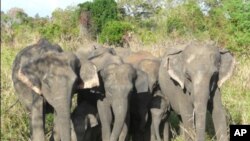Those who think of elephants as solitary, gentle giants lumbering quietly in their zoo enclosures might be surprised by the range and force of their distinctive calls to each other in the wild.
Shermin de Silva, a University of Pennsylvania biologist, identifies that as a “trumpet” sound, one of 14 distinct vocalizations she and her colleagues have recorded in Sri Lanka’s Uda Walawe National Park over the past six years.
“Trumpets are produced actually in situations of distress," says de Silva. "So they are not particularly happy vocalizations. They are either excited or distressed. But in addition to the trumpets, Asian elephants produce a very peculiar kind of sound that I call ‘squeaks.’"
“Squeaks tend to be produced also in situations of alarm and in situations of submission. So when an elephant is backing away from an opponent or backing away from in some cases, people, and alarmed by people or jackals or perceived threats, they also produced an elongated form of that called 'squeals.' ”
(Slideshow Courtesy Shermin de Silva/University of Pennsylvania School of Arts and Sciences)
Asian elephant calves often emit a sort of prolonged roar when they’re nursing or when they want attention.
“They also give long versions of the roar when they are separated," De Silva says. "And you see animals roaring as they are trying to find their social companions. What do we mean when we say an animal is ‘social?’ And that is a very big question.”
According to De Silva, elephant social life is based on a variety of female bonding behaviors. While some female elephants flit from one favored companion to another, others may visit a group of companions for days or even weeks, but always return to favored friends.
De Silva observed an elephant pair they named Kamala and Kanthi who were nearly inseparable.
“When I say that females are friends with one another, they actively have choices in where they go. So they can choose to be with somebody or not. Even though that choice is not apparent to us because all we see them doing is eating and moving. In the classic understanding of animal behavior, when two individuals are together spatially and they are together more often than you’d expect by coincidence, you are reasonably justified in thinking they prefer one another.”
In contrast, older male elephants tend to go it alone. Young males often seek to be in the rough vicinity of older males, even though little or no bonding takes place.
"African elephants...derive some kind of knowledge by following around these older males," De Silva says. "They learn their place in the hierarchy, and there are unfortunately even incidents where young males who are deprived of this kind of guidance from older males - or females - become boisterous and psychologically traumatized."
De Silva says another focus of her research was how the elephants impacted the Sri Lankan environment. Elephants till the soil with their tusks and dig large holes where water can collect. They also uproot trees, and plant seeds through their droppings.
Although elephants can come into conflict with humans if they raid or trample crops, de Silva says their activities can indirectly benefit humans too.
“If there aren’t elephants walking around dispersing seeds, there aren’t going to be any trees, and if there aren’t going to be trees of a particular kind that grow up to suck up water and create clouds, then that affects the water table. These are all indirect and long timescale interactions, but they are very important interactions.”
De Silva notes that poaching, habitat encroachment, climate change and other factors threaten wild Asian elephant herds, such as those in Uda Walawe.
According to the Wildlife Conservation Society, the population of Asian elephants has declined significantly in recent decades, and their survival in the wild is endangered.
De Silva says that is why it is essential to work with local people to find ways to live alongside these impressive creatures, in a way that will allow both human and elephant groups to thrive.








